Google+ unbiased review after week of preconceived use
One of our clients, immediately after the launch of Google+, asked to make a test of this social sphere for its promising projects. I will not give a complete test, for obvious reasons, but a part of it was adapted and brought to your attention.
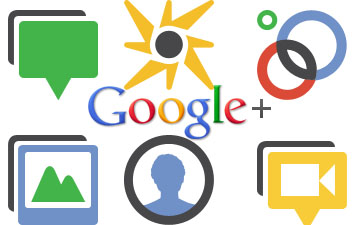
A week ago, Google made another attempt to break into the social networking market. Surprisingly, but the fact is that having almost a billion users in the asset, Google cannot combine them in its own social service, thereby finally entering people’s lives in almost all areas of the web. Well, and get the most out of your advertising, of course :)
Previous attempts by the company to enter the social sphere can not be called successful. Google’s first social network was Orkut. Unfortunately, it became widespread mainly in India and Brazil, Europe and the United States did not appreciate this network. Then there were stillborn, as they were later called, Buzz and Wave, as well as a number of smaller ones, such as Jaiku and Dodgeball.
')
And now a new attempt - Google+. Already at first glance it is clear that this product will surpass its predecessors. The interface in the style of new design, high speed, original idea with circles of contacts and neat integration into all Google services.
The main functionality is very similar to Buzz - the same live tape that tries to visualize any media content inserted into it with a comment thread. Such a tape - a mandatory attribute in almost all social networks - it can be seen in Facebook, Vkontakte, and many others. The Google+ feed looks more simple and clean from the outside, while offering a convenient navigation system between posts. The same can be observed in the Google Reader service. From the same shortcuts are taken: j - go to the next post, k - go back to the previous one.
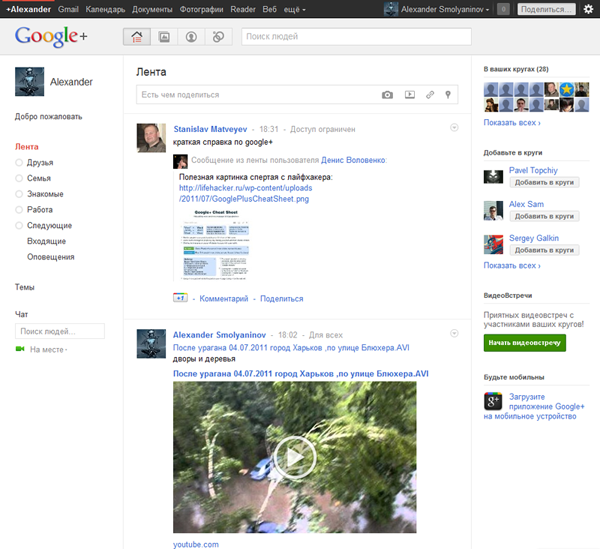
The main feature of the new network can be called the circles of contacts (circles). With their help, you can conveniently sort the entire list of contacts by areas of communication and interests. This is just one of those cases where it is better to see and try once than to read 100 times. The meaning of their work is that now the user can share his contact list by communication circle, and subsequently set up for these circles a different level of access to this or that information.
The interface of work with circles is thought out and made at a high technological level. Facebook developers have already paid attention to this wonderful new product and have released such an application for their social network without delay .
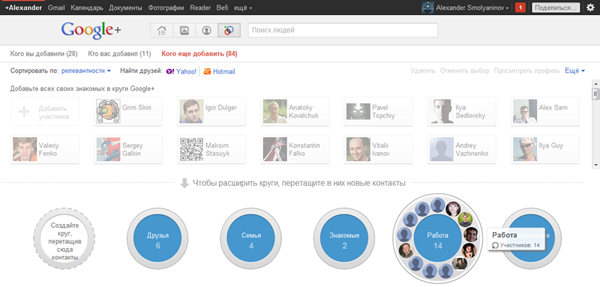
Many complained that with a large number of contacts, Facebook provides too much unnecessary information, and Twitter - too little. Google+ can be configured so that the information received exactly as much as the user can afford.
Another potentially powerful tool is video conferencing. With their help, Google can lure users of the corporate segment out of Facebook. It is free, has a minimum number of settings and supports simultaneous video chat for up to 10 people. At the same time, it is clear that the video conferencing function is still quite raw - the video is not broadcast in the best quality, there is dissynchronization of the video and audio stream, which is directly proportional to the conference time, the problem with the audio card drivers, as well as insufficient cross browser compatibility. In Skype, the quality of the video looks better.

If the fact that everyone's favorite Internet Explorer is supported only from version 8 cannot help
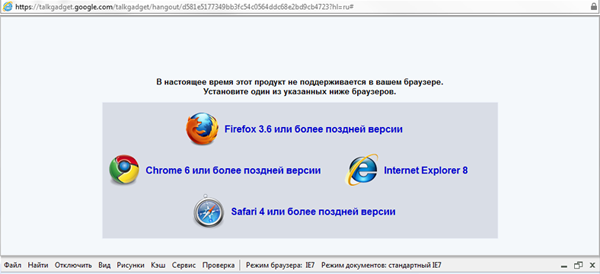
then, the problems in Firefox 5 and Opera 11 are a little upset - they found problems with both video and audio. And looking at the code, you can see that the layout of the interface also makes you want something better.

Problems with cross-browsing were evident, for example, in the fact that in IE8 for some reason the chat panel suddenly slid into the lower right corner.

On a laptop in Firefox 5, it was amazing to see the following picture:
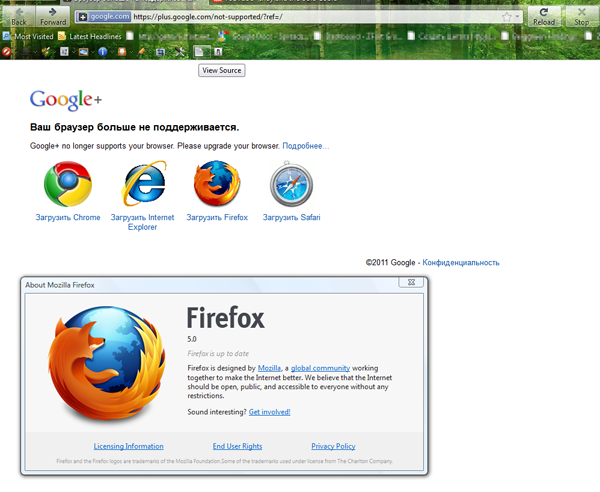
The project is still being finalized, so it is hoped that in the final version all the shortcomings will be eliminated.
An interesting feature is the ability to insert a stream of youtube in real time in the process of video conferencing. In this case, the voices of communicating contacts are strongly muffled. At the same time, by holding the microphone icon, you can reclaim the sound and, for example, comment on what is happening in the video.
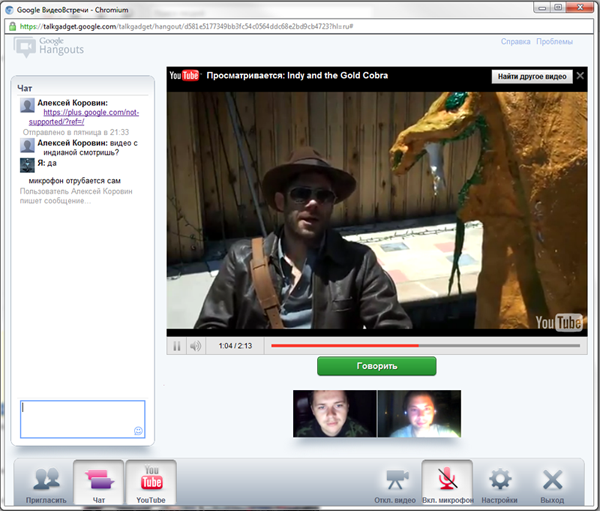
Entertaining robot from sprite,
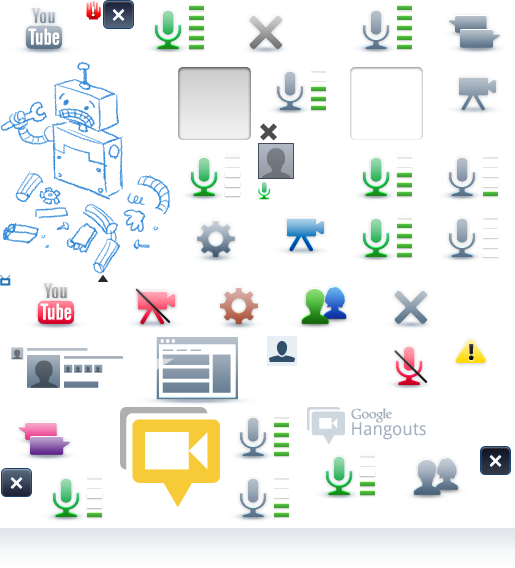
which contains all the interface elements of the video chat pop-up window, came in handy when displaying an error message after interrupting a video connection.

Overall, video chat looks like a promising and quite functional application.
The next global section is Photo. This is a separate song. Not only is it tightly integrated with the Picasa service, it also expands its capabilities - which is only worth the offer to host an unlimited number of images up to 2048 pixels in size and video up to 15 minutes long. Visually, again, everything here is at the highest level. Photos shared from circles are displayed as one solid wall.
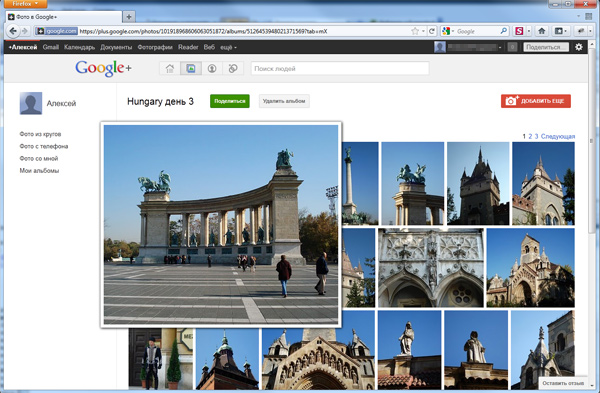

When the browser window is resized, images are automatically resized. This allows you to get rid of empty space, set the gallery view of a solid tape and also achieve the same display at different screen resolutions. When commenting on a certain photo, a corresponding indicator appears in its upper right corner.

Uploading new photos is practically no different from how it is implemented in other social networks.
The section "My Albums" in the same way displays user-created albums. At first glance, the section is like a section, but when you hover on any of the albums, you can observe an interesting hover effect, implemented using the CSS3 property - 'transform'. Internet Explorer users will not see it, but is this not proof that you need to more actively switch to browsers that maximize support for modern web standards.

In general, working with image galleries leaves a pleasant feeling, well thought out and easy to use.

Users of mobile devices are also not deprived of attention - now there is already a fairly functional application for Android, and the version for iOS of the system is waiting for approval in the App Store. The mobile version of the website is also well done.
The main question that all browsers and Google+ users are now asking is whether it can compete with Facebook. Almost all active Internet users have their Facebook account, and this is currently more than half a billion people. And while it is not obvious why they should abandon the popular and already familiar service in favor of the new and still relatively raw.
The video conferencing function could be one killer feature, which would be pulled by both corporate and ordinary users, each with its own purpose. But just a few days ago, the ubiquitous journalists of technical portals learned that next week Facebook is going to provide Skype-based video chat to its users. And, I'm afraid that it will be more functional than on Google+.
On the other hand, Google has a huge set of its own services that cover almost all areas of network life, which is not in Facebook. Based on the latest data, they are used monthly by one billion users of the global network. And if you carefully and unobtrusively integrate G + into these services, you can gradually increase the user base to such an extent that Facebook never dreamed of. It is worth noting that the project has a number of promising innovations that are already making a fresh impetus to the further development of social services.
Yes, almost all previous attempts of the search giant were not successful, but should they succeed sometime? A company with such resources and turnover cannot learn from its own mistakes. If it doesn’t take off this time either, then management will need to either seriously take on personnel changes, or seriously reconsider their approach to the development of social networks and maybe look at them from a different angle.

A week ago, Google made another attempt to break into the social networking market. Surprisingly, but the fact is that having almost a billion users in the asset, Google cannot combine them in its own social service, thereby finally entering people’s lives in almost all areas of the web. Well, and get the most out of your advertising, of course :)
Previous attempts by the company to enter the social sphere can not be called successful. Google’s first social network was Orkut. Unfortunately, it became widespread mainly in India and Brazil, Europe and the United States did not appreciate this network. Then there were stillborn, as they were later called, Buzz and Wave, as well as a number of smaller ones, such as Jaiku and Dodgeball.
')
And now a new attempt - Google+. Already at first glance it is clear that this product will surpass its predecessors. The interface in the style of new design, high speed, original idea with circles of contacts and neat integration into all Google services.
The main functionality is very similar to Buzz - the same live tape that tries to visualize any media content inserted into it with a comment thread. Such a tape - a mandatory attribute in almost all social networks - it can be seen in Facebook, Vkontakte, and many others. The Google+ feed looks more simple and clean from the outside, while offering a convenient navigation system between posts. The same can be observed in the Google Reader service. From the same shortcuts are taken: j - go to the next post, k - go back to the previous one.

The main feature of the new network can be called the circles of contacts (circles). With their help, you can conveniently sort the entire list of contacts by areas of communication and interests. This is just one of those cases where it is better to see and try once than to read 100 times. The meaning of their work is that now the user can share his contact list by communication circle, and subsequently set up for these circles a different level of access to this or that information.
The interface of work with circles is thought out and made at a high technological level. Facebook developers have already paid attention to this wonderful new product and have released such an application for their social network without delay .

Many complained that with a large number of contacts, Facebook provides too much unnecessary information, and Twitter - too little. Google+ can be configured so that the information received exactly as much as the user can afford.
Another potentially powerful tool is video conferencing. With their help, Google can lure users of the corporate segment out of Facebook. It is free, has a minimum number of settings and supports simultaneous video chat for up to 10 people. At the same time, it is clear that the video conferencing function is still quite raw - the video is not broadcast in the best quality, there is dissynchronization of the video and audio stream, which is directly proportional to the conference time, the problem with the audio card drivers, as well as insufficient cross browser compatibility. In Skype, the quality of the video looks better.

If the fact that everyone's favorite Internet Explorer is supported only from version 8 cannot help

then, the problems in Firefox 5 and Opera 11 are a little upset - they found problems with both video and audio. And looking at the code, you can see that the layout of the interface also makes you want something better.

Problems with cross-browsing were evident, for example, in the fact that in IE8 for some reason the chat panel suddenly slid into the lower right corner.

On a laptop in Firefox 5, it was amazing to see the following picture:

The project is still being finalized, so it is hoped that in the final version all the shortcomings will be eliminated.
An interesting feature is the ability to insert a stream of youtube in real time in the process of video conferencing. In this case, the voices of communicating contacts are strongly muffled. At the same time, by holding the microphone icon, you can reclaim the sound and, for example, comment on what is happening in the video.

Entertaining robot from sprite,

which contains all the interface elements of the video chat pop-up window, came in handy when displaying an error message after interrupting a video connection.

Overall, video chat looks like a promising and quite functional application.
The next global section is Photo. This is a separate song. Not only is it tightly integrated with the Picasa service, it also expands its capabilities - which is only worth the offer to host an unlimited number of images up to 2048 pixels in size and video up to 15 minutes long. Visually, again, everything here is at the highest level. Photos shared from circles are displayed as one solid wall.


When the browser window is resized, images are automatically resized. This allows you to get rid of empty space, set the gallery view of a solid tape and also achieve the same display at different screen resolutions. When commenting on a certain photo, a corresponding indicator appears in its upper right corner.

Uploading new photos is practically no different from how it is implemented in other social networks.
The section "My Albums" in the same way displays user-created albums. At first glance, the section is like a section, but when you hover on any of the albums, you can observe an interesting hover effect, implemented using the CSS3 property - 'transform'. Internet Explorer users will not see it, but is this not proof that you need to more actively switch to browsers that maximize support for modern web standards.

In general, working with image galleries leaves a pleasant feeling, well thought out and easy to use.

Users of mobile devices are also not deprived of attention - now there is already a fairly functional application for Android, and the version for iOS of the system is waiting for approval in the App Store. The mobile version of the website is also well done.
The main question that all browsers and Google+ users are now asking is whether it can compete with Facebook. Almost all active Internet users have their Facebook account, and this is currently more than half a billion people. And while it is not obvious why they should abandon the popular and already familiar service in favor of the new and still relatively raw.
The video conferencing function could be one killer feature, which would be pulled by both corporate and ordinary users, each with its own purpose. But just a few days ago, the ubiquitous journalists of technical portals learned that next week Facebook is going to provide Skype-based video chat to its users. And, I'm afraid that it will be more functional than on Google+.
On the other hand, Google has a huge set of its own services that cover almost all areas of network life, which is not in Facebook. Based on the latest data, they are used monthly by one billion users of the global network. And if you carefully and unobtrusively integrate G + into these services, you can gradually increase the user base to such an extent that Facebook never dreamed of. It is worth noting that the project has a number of promising innovations that are already making a fresh impetus to the further development of social services.
Yes, almost all previous attempts of the search giant were not successful, but should they succeed sometime? A company with such resources and turnover cannot learn from its own mistakes. If it doesn’t take off this time either, then management will need to either seriously take on personnel changes, or seriously reconsider their approach to the development of social networks and maybe look at them from a different angle.
Source: https://habr.com/ru/post/123536/
All Articles